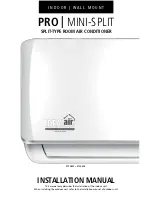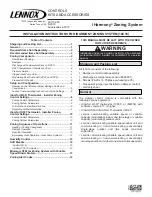
3 Preparation
Installation manual
5
EBLQ+EDLQ011~W1
Daikin Altherma low temperature monobloc
4P522031-1 – 2018.01
ENERG
IJA
Y
IA
IE
ENERG
IJA
Y
IA
IE
1×
1×
1×
1×
1×
a
b
c
d
2×
2×
f
e
g
a
General safety precautions
b
Addendum book for optional equipment
c
Outdoor unit installation manual
d
Operation manual
e
Sealing ring for shut-off valve
f
Shut-off valve
g
Energy label
3
Preparation
3.1
Preparing the installation site
3.1.1
Installation site requirements of the
outdoor unit
Mind the spacing guidelines. See figure 1 on the inside of the front
cover.
The symbols can be interpreted as follows:
A,C
Left side and right side obstacles (walls/baffle plates)
B
Suction side obstacle (wall/baffle plate)
D
Discharge side obstacle (wall/baffle plate)
E
Top side obstacle (roof)
a,b,c,d,e
Minimum service space between the unit and obstacles A,
B, C, D and E
*
If shut-off valves are NOT installed on the unit
†
If shut-off valves are installed on the unit
e
B
Maximum distance between the unit and the edge of
obstacle E, in the direction of obstacle B
e
D
Maximum distance between the unit and the edge of
obstacle E, in the direction of obstacle D
H
U
Height of the unit including the installation structure
H
B
,H
D
Height of obstacles B and D
H
Height of installation structure below the unit
INFORMATION
If shut-off valves are installed on the unit, provide a
minimum space of 400 mm at the air inlet side. If shut‑off
valves are NOT installed on the unit, provide a minimum
space of 250 mm.
If the system contains a domestic hot water tank, meet the following
requirements:
Maximum allowable distance
between outdoor unit and …
Distance
domestic hot water tank
10 m
3‑way valve
10 m
The outdoor unit is designed for outdoor installation only, and for
ambient temperatures ranging 10~43°C in cooling mode, –25~25°C
in space heating mode, and –25~35°C in domestic hot water
operation mode.
3.2
Preparing water piping
NOTICE
In case of plastic pipes, make sure they are fully oxygen
diffusion tight according to DIN 4726. The diffusion of
oxygen into the piping can lead to excessive corrosion.
3.2.1
To check the water volume and flow rate
The outdoor unit has an expansion vessel of 7 litre with a factory-set
pre-pressure of 1 bar.
See the installer reference guide for more information.
To make sure that the unit operates properly:
▪ You must check the minimum and maximum water volume.
▪ You might need to adjust the pre-pressure of the expansion
vessel.
Minimum water volume
If
Then
The system contains a backup heater or
a DHW tank with recirculation pump
The minimum water
volume is 20 l
(a)
The system does NOT contain a backup
heater or a DHW tank with recirculation
pump
The minimum water
volume is 80 l
(a)(b)
(a)
The internal water volume of the outdoor unit NOT
included.
(b)
If an EKHWP tank is installed, no recirculation pump is
required.
INFORMATION
In critical processes, or in rooms with a high heat load,
extra water might be required.
NOTICE
When circulation in each space heating/cooling loop is
controlled by remotely controlled valves, it is important that
the minimum water volume is guaranteed, even if all of the
valves are closed.
The following illustration shows a setup with remotely controlled
valves:
FHL1
FHL2
FHL3
M1
T1
T3
T2
M2
M3
f
g
d
d
a
e
b c
a
Outdoor unit
b
Heat exchanger
c
Pump
d
Shut‑off valve
e
Backup heater kit (optional)
f
Collector (field supply)
g
By‑pass valve (field supply)
FHL1...3
Floor heating loop (field supply)
T1...3
Individual room thermostat (optional)
M1...3
Individual motorised valve to control loop FHL1...3 (field
supply)
Maximum water volume
NOTICE
The maximum water volume depends on whether glycol is
added to the water circuit. For more information on the
addition of glycol, refer to
"4.3.3 To protect the water circuit
against freezing" on page 9
.
Use the following graph to determine the maximum water volume for
the calculated pre-pressure.






































